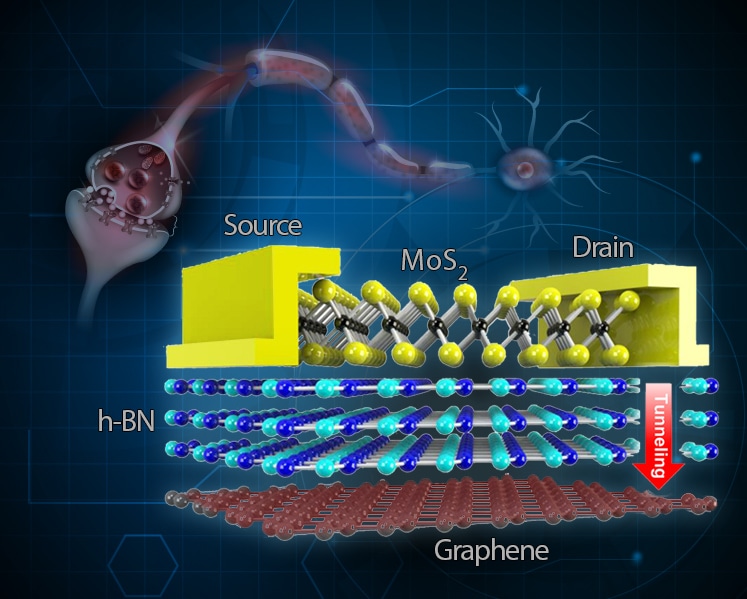Sep 6 2016
 Comparison between the synapse and the two-terminal tunnelling random access memory (TRAM). In the junctions (synapses) between neurons, signals are transmitted from one neuron to the next. TRAM is made by a stack of different layers: A semiconductor molybdenum disulfide (MoS2) layer with two electrodes (drain and source), an insulating hexagonal boron nitride (h-BN) layer and graphene layer.
Comparison between the synapse and the two-terminal tunnelling random access memory (TRAM). In the junctions (synapses) between neurons, signals are transmitted from one neuron to the next. TRAM is made by a stack of different layers: A semiconductor molybdenum disulfide (MoS2) layer with two electrodes (drain and source), an insulating hexagonal boron nitride (h-BN) layer and graphene layer.
In March 2016, AlphaGo, the artificial intelligence (AI) program beat LEE Se-Dol, the Korean Go champion at the Asian board game.
The game was quite tight, but AlphaGo used 1200 CPUs and 56,000 watts per hour, while Lee used only 20 watts. If a hardware that mimics the human brain structure is developed, we can operate artificial intelligence with less power.
Professor YU Woo Jong
Scientists from the Center for Integrated Nanostructure Physics within the Institute for Basic Science (IBS) collaborated with Sungkyunkwan University to develop a new memory device that is inspired by the neuron connections in the human brain. The details of the study have been published in the journal, Nature Communications.
The reported highlights the devices reliable performance, endurance, and long retention time. The device is both stretchable and flexible, which makes it useful for developing next-gen soft electronics fixed to body or clothes.
The numerous neuron connections in the brain make it possible for the organ to learn and memorize. The information memorized is transmitted in the form of an electro-chemical signal from one neuron to another through synapses.
The researchers at IBS drew inspiration from these connections and developed a memory known as two-terminal tunneling random access memory (TRAM).
There are two electrodes in TRAM that are similar to the two communicating neurons of the synapse, and are called source and drain. Unlike three-terminal flash memory in mainstream mobile electronics, such as mobile phones and digital cameras, two-terminal memories like TRAM do not require a rigid and thick oxide layer.
Flash memory is still more reliable and has better performance, but TRAM is more flexible and can be scalable.
Professor YU Woo Jong
Three 2D crystal layers of one-atom or a few-atom thick are stacked up to create TRAM. These layers include the semiconductor molybdenum disulfide (MoS2) with two electrodes (source and drain), a graphene layer, and an insulating layer of hexagonal boron nitride (h-BN).
The data is stored by TRAM, which keeps the electrons in the graphene layer. When electricity is applied between the electrode in different voltages, the electrons tunnel from the graphene layer through the insulating h-BN layer.
When the graphene layer becomes negatively charged, memory is written and stored and vice versa. Introducing positive charges in the graphene layer erases the memory.
The researchers selected the optimal thickness of the insulating h-BN layer to be 7.5 nm after careful examination. At this thickness the layer allows the electrons to tunnel to the graphene layer from the drain electrode without losing flexibility or any leakage.
TRAM’s two main features are stretchability and flexibility. When fabricated on flexible plastic (PET), TRAM could be strained up to 0.5%, while TRAM fabricated using stretchable silicone materials (PDMS) could be strained up to 20%.
TRAM can be used to save data from wearable smartphones, smart surgical gloves, body-attachable biomedical devices, and eye cameras.
The performance of TRAM exceeds that of other two-terminal memories, such as resistive random-access memory (RRAM) and phase-change random-access memory (PRAM).